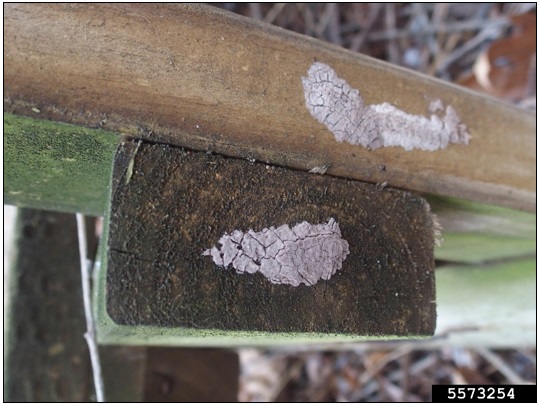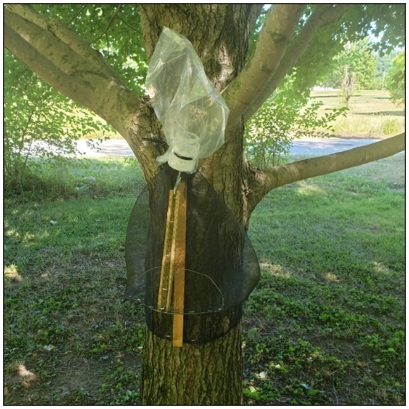Hot Topic: Spotted Lanternfly

Figure 1. Adult spotted lanternfly; Figure 2. Spotted lanternfly nymph (Lawrence Barringer, Pennsylvania Department of Agriculture, Bugwood.org)
The spotted lanternfly (Lycorma delicatula) is a planthopper that is native to Asia. It was first discovered in the US in Berks County, Pennsylvania and has since spread to at least 14 states, with large infestations present in New York, Delaware, and New Jersey. The spotted lanternfly has been reported to feed on over a hundred species of plants, including grapes, maples, apples, pears, and the invasive plant tree of heaven. This insect has become a major agricultural, forestry, and residential pest in its introduced range and could potentially cause billions of dollars in economic losses.
Spotted lanternfly eggs hatch in early summer and nymphs feed until reaching maturity in late summer or early fall. Adults begin mating and laying eggs in the early fall and die off in the winter. These insects overwinter as eggs and emerge in the early summer, restarting the cycle.
The spotted lanternfly is commonly spread by humans who unwittingly transport them. These insects can lay their eggs on nearly any hard surface, including vehicles, firewood, and outdoor furniture. They can also be spread through the horticultural trade. It is important to check your vehicles and other personal belongings for spotted lanternfly egg masses before leaving areas known to be infested by the spotted lanternfly to prevent the spread of this insect to new locations.

Figure 3. Spotted lanternfly egg masses (Emelie Swackhamer Penn State University, Bugwood.org)
The Spotted Lanternfly is now established in Kentucky
A CURRENT MAP WITH THE CURRENT DISTRIBUTION OF THE SPOTTED LANTERNFLY IN THE US CAN BE FOUND ON THIS WEBPAGE: https://experience.arcgis.com/experience/2c4f8af5fa7548099f0138d2989b7ed1/
The spotted lanternfly was found in Kentucky in Gallatin County in October 2023. Several adult spotted lanternflies, including a mating pair, and egg masses were found on a property that has several trees of heaven infestations. Another infestation was found in Gallatin County about 15 miles away from the initial site. The spotted lanternfly has been found in several states bordering Kentucky, including Ohio, Indiana, Virginia, West Virginia, and Tennessee.
What is being done?

Figure 5. Circle trap
Due to the close proximity of the infestations in Indiana and Ohio to the Kentucky border, surveys are being conducted in northern Kentucky to detect any potential spotted lanternfly introductions into the state. Nurseries, vineyards, botanical gardens, forests, and public parks in the region are being inspected for signs of spotted lanternfly infestation. Circle traps have also been set at these sites to assist in surveying efforts. Circle traps are metal mesh funnels that are attached to a tree to direct spotted lanternflies upwards into a collection bag that they are unable to escape from. These traps can help determine if this pest is present, which life stage the population is in, and give population size estimates.
Information for Homeowners
The website www.hungrypests.com has excellent information about the spotted lanternfly and other pests of concern.
Do Your Part!
If you think you see the spotted lanternfly, take a picture, squish it, and report it! You can report sightings of the spotted lanternfly and other invasive pests by sending an email to ReportAPest@uky.edu.
